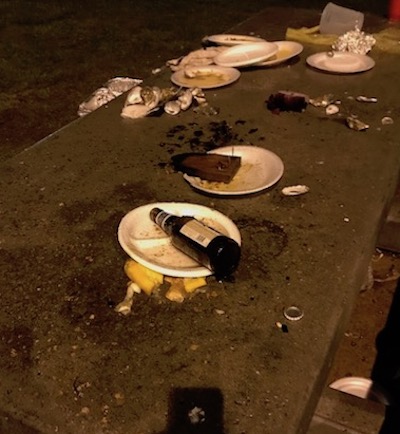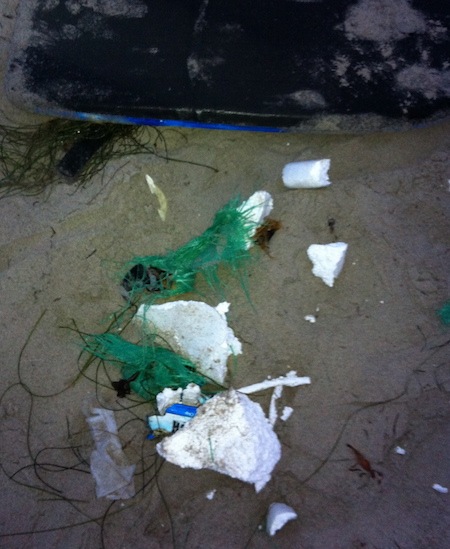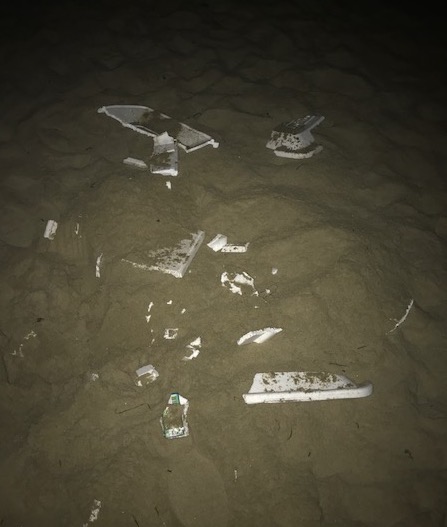Over the last several months, I have taken a few pictures of the effect of styrofoam on beaches. There are days when one can walk for 1 mile along a path of nurdles that look like this.

Most of these small round beads of styrofoam come from disposable boogie boards and disposable coolers.

One of the issues coming up in the here in San Diego, is the banning of Styrofoam or expanded polystyrene. The ban would restrict sales and distribution of food service items, take out food containers, including fish and meat trays, egg cartons, coolers and beach toys made with expanded polystyrene, also called EPS. ALL of the listed items (except egg cartons) can be found at Belmont Park daily… Daily and not just one item.


Add in the now trending item.. disposable surfboards.. and the styrofoam on beaches increases.

I have never seen a paper plate that is picked apart like styrofoam from seagulls.

The reality, is these people did not have to bring styrofoam to the beach. There are many other options to choose for plates when going to the beach

Councilman Chris Ward, (proposal’s author) and Councilwomen Barbara Bry and Myrtle Cole voted in favor of the proposal. Councilmen Mark Kersey and Chris Cate voted no.
Much is the styrofoam is brought in along with other picnic items.


Many People are not responsible…. in fact rarely do you find clean tables at any of the picnic tables at either South Mission Beach Jetty, Bonita Cove or Belmont Park.



Banning Styrofoam is not new. Both Sonoma and Carmel became the first two cities to ban plastic foam containers in 1989 and over 100 Cities in California have banned styrofoam.

As with every banning, there are two sides to every story:


- 2.3 Million Tons of Styrofoam land up in landfills in the USA. That is a lot of styrofoam, since it weighs nothing.
- 7% of the nearly 33.54 million tons of plastic Americans discard annually is styrofoam.

Styrofoam meat packaging on July 19, 2018. Not at common as boogie boards and disposal coolers, but fish bait along with hamburgers and other meat products for BBQ come in these packaging wrapped in plastic. 
Styrofoam in front of Fire Pits is very commons during the summer - Restaurants say that banning styrofoam would mean higher cost for businesses. They will just pass the cost on to customers.

Ice Cream cups on the high tide line. Plastic cup along with plastic utensils - 14 million tonnes of polystyrene are produced every year around the world. Given its light weight –Styrofoam is 95% air , so this is a huge volume and remember this is toxic.

The remain of a disposable Cooler on July 9 2018. About to be washed out on the tide. You cannot get all of these pieces . 
Another broken disposal cooler at Belmont Park, along with a boogie board. 
Packaging cooler was left at the South Mission Beach jetty. These easily break apart. - 3 million tons of polystyrene produced in the U.S., 2.3 million tons end up in landfills,, the rest ends up in water.
- Styrofoam little or no scrap value, which means there is little or no use for recycling. Although there are ways to reuse. But most cities do not have the infrastructure to recycled styrofoam. Right now they are struggling with recycling in general.
- San Diego collected more than 12,500 pieces of the material along San Diego beaches last year.


California uses 165,000 TONS of plastic foam food containers annually!
The other side of the story, just to be fair:
- “A proposed ban only harms the small business owner and will not reduce waste. We need sensible solutions that modernize and stimulate investment of our domestic recycling infrastructure… A ban would only create more mixed paper and would do nothing to help the environment, reduce landfill waste, or actually create solutions for a more stable and thriving recycling industry.” (The San Diego Regional Chamber of Commerce )

Styrofoam ice cream intermixed with cardboard litter beaches and picnic areas. - Banning Styrofoam creates other problems. The material is used widely in the food and packaging industries and such industries typically provide ownership and employment opportunities for minorities. In 2014, New York City collected an estimated 28,500 tons of plastic foam, about 90 percent of which came from single-use containers for the customers of food vendors and restaurants. Vendors using foam containers are less able to absorb the costs of switching to more environmentally friendly materials because many are small businesses that operate on thin profit margins. Bans also impose costs on the foam manufacturing industry. The direct and indirect impacts of prohibiting EPS manufacturing in New York could eliminate 2,000 jobs and $400 million in economic activity. In California, an estimated 8,000 jobs could disappear. (Source)

- Replacing Styrofoam with other products can increase waste mass and energy use. For instance using paper products is one of the worse environmental impacts.

This foam container was just left on the sea wall in front of Belmont Park Unfortunately this is another common site. The closest trash can was 2 feet away.
I am going to add my 2 Cents. 1) Nobody is saying to ban styrofoam completely. Just in areas where it effects the environment and especially the plastic polluted ocean. 
2.) The issue of jobs. One is torn.. do we lose jobs on land or do we lose jobs on sea? With plastic polluting the ocean and land, the amount of jobs being lost due to plastic pollution overall far outweighs the loss of jobs and economic activity on land.
3.) Increase cost to restaurants- they will just pass the cost on to their customers.
4.) There are many, many other alternatives to styrofoam in take out food. Some might cost a few more.. but people WILL NOT stop taking take out because they have to pay more.
5.) We as a community need to relook at our waste and what we use and what we can recycle. We need to start thinking about a circular economy, not a throwaway economy. If banning both straws and styrofoam gets people to start thinking in this direction.. that would be fantastic!
All of that said:
The sky is NOT going to fall down if styrofoam is banned at seacoasts. It hasn’t fallen down in 120+ other cities and it will not fall down here. It didn’t fall down when they banned smoking in restaurants, it didn’t fall down when they banned plastic bags.
NOBODY Will die if they ban styrofoam. In fact both people and animals will live. This is not a traumatic event.
Resources
- Styrofoam Dilemna
- Supply Chain Sustainability
- Groundswell
- Independent: Banning Styrofoam Could Cause Problems
